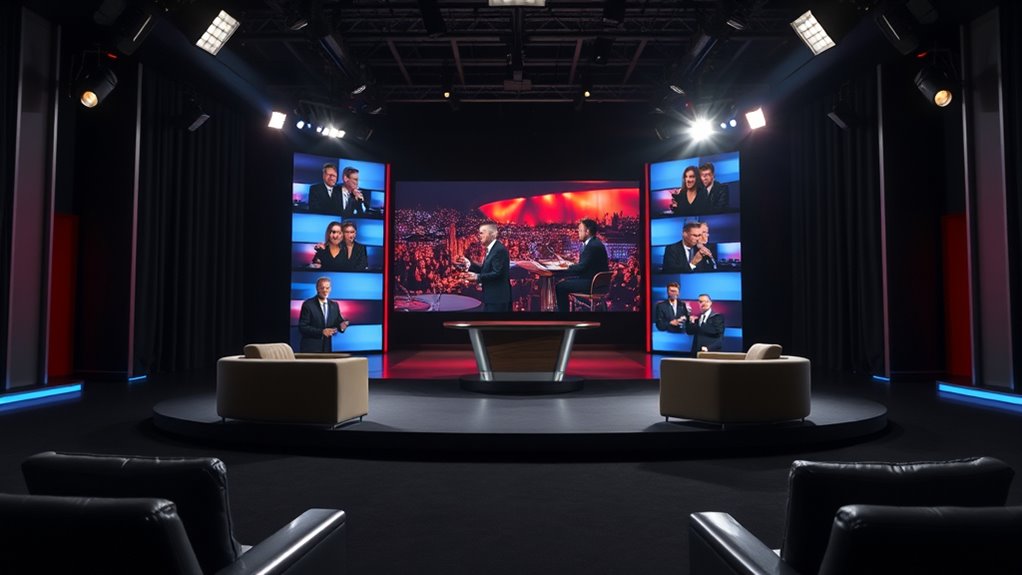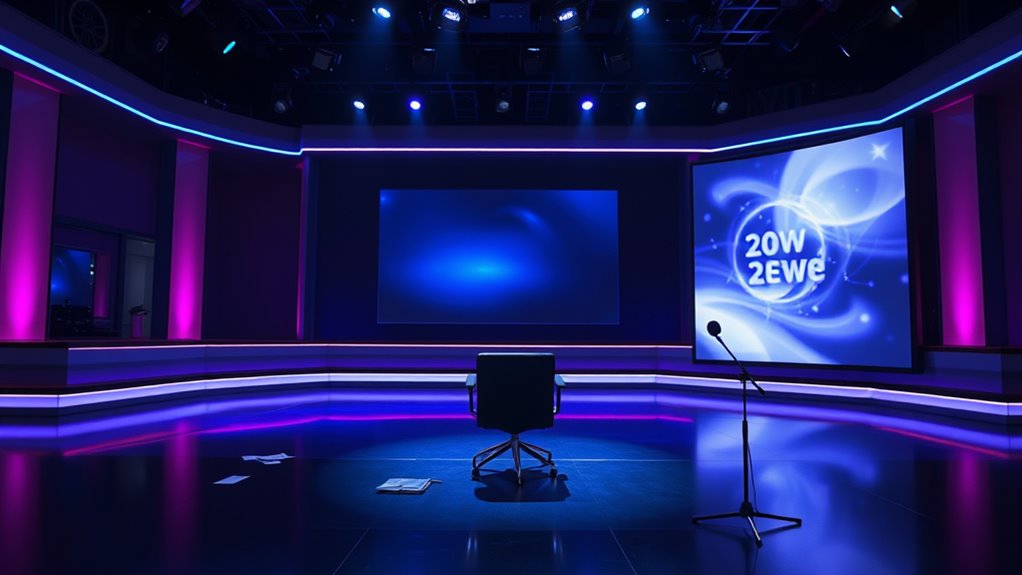After Kimmel’s controversy, you’ll see a shift across late-night TV, with networks adopting more flexible programming and stricter content guidelines. Hosts’ behavior and commentary come under increased scrutiny, and audiences are more divided than ever. Advertisers want clarity on brand safety, which influences show support. As the landscape evolves, opportunities for new formats and voices grow—if you’re curious about how these changes could shape your favorite shows, keep exploring further.

The impact extends beyond ABC, affecting the entire late-night landscape. Networks now face increasing pressure to develop flexible programming strategies that can adapt quickly to host absences or controversies. Historically stable late-night slots are likely to see more experimentation, with new formats or interim hosts stepping in to fill the gaps. Competitors might seize this moment to attract viewers by offering alternative or edgier content, capitalizing on the disruption. Meanwhile, the incident is prompting renewal discussions and contract renegotiations for existing hosts, with a focus on how political and social commentary is handled on-air and online. These conversations could lead to stricter guidelines and oversight, aiming to prevent similar incidents in the future. Increased scrutiny from regulators and broadcasters is also influencing how content is curated and presented on late-night shows. Audience reactions are highly polarized, fueling debates on social media and shaping viewership trends. Kimmel’s suspension has sparked heated discussions, with some viewers defending his right to free speech, while others see the comments as crossing a line. Overall, late-night audiences are becoming more fragmented, influenced heavily by digital media and streaming options, which allow viewers to cherry-pick content that aligns with their preferences. This shift may cause networks to reexamine the tone and persona of their hosts, balancing humor and commentary with the risk of alienating segments of their audience. For advertisers, the controversy amplifies concerns about brand safety and social responsibility. Many sponsors are now demanding more transparency about content guidelines and host conduct, with some pausing their advertising until they see clearer policies. Long-term support for shows like Kimmel’s could hinge on how well networks manage these reputational risks moving forward. Ultimately, this incident highlights a new era for late-night TV—one marked by increased scrutiny of host behavior, calls for moderation, and opportunities for emerging voices to step into the spotlight. Additionally, as audiences seek more nature exposure, networks may explore integrating wellness themes into their programming to resonate with viewers’ desires for holistic content.
Frequently Asked Questions
How Will Kimmel’s Departure Impact Late-Night Ratings?
Kimmel’s departure will likely cause ratings to decline, especially for ABC’s Jimmy Kimmel Live!. You might see viewers shift to Colbert’s show or explore streaming and podcasts for late-night content. The loss of Kimmel’s personality and loyal audience could lead to a drop in overall viewership and the 18-49 demo, forcing networks to re-evaluate their strategies to keep late-night relevant and competitive.
Who Are the Leading Contenders to Replace Kimmel?
You should consider seasoned hosts like Stephen Colbert or Seth Meyers, who have proven political and cultural commentary skills and strong fan bases. Younger comedians like Hasan Minhaj or social media influencers could bring fresh appeal. Diversity is also key, so female comedians like Tiffany Haddish or Samantha Bee might broaden the audience. Focus on hosts who balance humor, social awareness, and audience engagement to guarantee stability and growth in ratings.
What Are Viewers’ Opinions on the Future of Late-Night TV?
You believe the future of late-night TV depends on innovation and digital integration. Viewers want authentic, timely humor, and fresh content that reflects current events. You’re open to new formats, hybrid shows, and hosts who engage with social media and trending topics. While traditional formats still appeal to older audiences, younger viewers seek more social issues and interactive elements. Overall, you see potential for late-night TV to evolve and survive with creative changes.
Will There Be Changes in Late-Night Show Formats?
Yes, late-night show formats will change considerably. You’ll see more digital-driven content, with shows evolving into shorter, more authentic segments designed for social media. Traditional studio setups will give way to online platforms offering lower costs and direct audience engagement. This shift means you’ll experience less of the classic, glitzy format and more personalized, viral content tailored for the digital age, making late-night entertainment more accessible and adaptable to your viewing habits.
How Might This Shift Affect Late-Night Comedy Styles?
This shift will make your late-night comedy more cautious and diverse. You might see less harsh political satire and more inclusive, sensitive humor to avoid controversy. The focus will likely move toward interactive segments, multimedia use, and podcasts, giving you fresh formats to enjoy. As audiences seek relatable, socially aware content, your favorite shows may become more experimental, blending comedy with meaningful cultural commentary to stay relevant and engaging.
Conclusion
As the landscape shifts after Kimmel, your favorite late-night shows are like a river changing course, carving new paths through the entertainment world. Change may feel uncertain, but it also opens doors for fresh voices and bold ideas. Keep your eyes open, because the future of late-night TV is a canvas waiting for new stories to be painted. Embrace the transformation—it’s the dawn of a vibrant new chapter.









